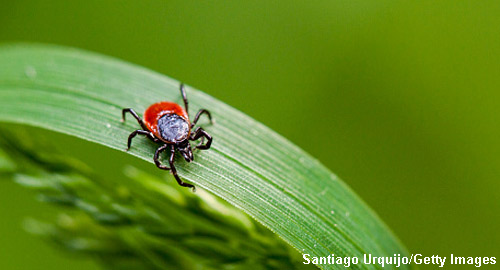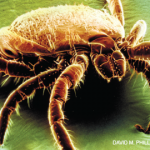 Canadian public health officials recognize Lyme disease as a significant, emerging tick-borne illness. Since the early 1990s, the tick Ixodes scapularis has been seen in Canada, and scientists predict that due to climate change, its range will continue to expand northward. This information is important to physicians because this particular tick species can carry Borrelia burgdorferi, the causative agent of Lyme disease. Migratory birds, deer and small mammals all play a role in tick dispersal. As time passes, the tick population is experiencing range-front expansion and the colonization of woodland habitats behind that range front.
Canadian public health officials recognize Lyme disease as a significant, emerging tick-borne illness. Since the early 1990s, the tick Ixodes scapularis has been seen in Canada, and scientists predict that due to climate change, its range will continue to expand northward. This information is important to physicians because this particular tick species can carry Borrelia burgdorferi, the causative agent of Lyme disease. Migratory birds, deer and small mammals all play a role in tick dispersal. As time passes, the tick population is experiencing range-front expansion and the colonization of woodland habitats behind that range front.
Katie M. Clow, PhD, formerly a graduate student at the University of Guelph in Ontario, Canada, and colleagues published new data that highlight the current geographic area associated with Lyme disease. The research takes advantage of improved surveillance approaches, which have evolved since the risk from Ixodes scapluaris was first identified. The authors suggest that their paper, published Dec. 17 in PLoS One, may be useful for targeting public health interventions to the areas of greatest risk.1
The investigators’ defined their primary cluster as a geographic area encompassing 15 of 21 sites that tested positive for Ixodes scapularis in 2014. For the current study, they chose to sample four sites within a 46 km buffer of the primary cluster and 32 sites within a 92 km buffer of the primary cluster. Thus, researchers sampled a total of 36 field sites in 2016. They detected Ixodes scapularis in 17 of these and note that their study was the first to detect Ixodes scapularis in five of these sites. The team then used their data to determine that the ticks are expanding their range at a rate of 46–55 km/year.
The researchers then looked more closely at Borrelia burgdorferi. In eight of the sites tested positive for Ixodes scapularis, they found that the ticks also tested positive for Borrelia burgdorferi. “We have illustrated the ongoing spatial spread of [Ixodes] scapularis and the emergence of [Borrelia] burgdorferi in Ontario, Canada, especially around the hot spot in eastern Ontario,” write the authors in their conclusion. “With field collected data, we explored the speed of spread model for [Ixodes] scapularis and showed that on a short timescale, the process of [Ixodes] scapularis invasion is consistent with the estimated rate of 46 km/year. However, this speed may not be uniform and the following colonization of [Ixodes] scapularis behind the range front is occurring at a heterogeneous rate.”


